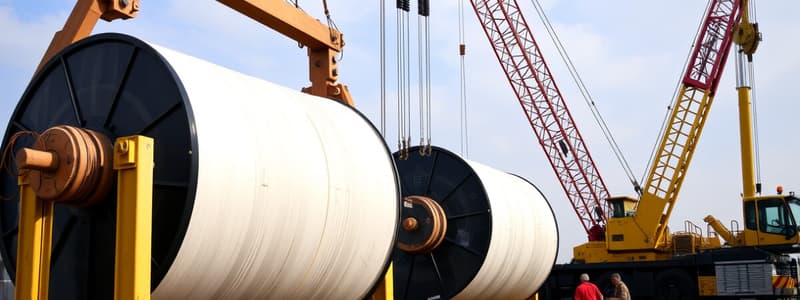Podcast
Questions and Answers
What is the primary aim of periodic inspection for wire ropes?
What is the primary aim of periodic inspection for wire ropes?
- To improve the overall aesthetic of the rope
- To estimate the total weight the rope can lift
- To determine if the rope can safely remain in service (correct)
- To replace the rope with a new one
Where should particular attention be paid during the inspection of wire ropes?
Where should particular attention be paid during the inspection of wire ropes?
- Environmental conditions
- Rope drum anchorage (correct)
- Rope length variations
- Rope color changes
How often should periodic inspections be conducted for lifting appliances?
How often should periodic inspections be conducted for lifting appliances?
- Every 6 months for people carrying machines (correct)
- Every 3 months
- Every 18 months
- Every 24 months
What issue might be observed at the entry of ropes into detachable terminations?
What issue might be observed at the entry of ropes into detachable terminations?
Which section of the rope is prone to damage from abrasion?
Which section of the rope is prone to damage from abrasion?
What should be inspected for signs of slippage during rope examination?
What should be inspected for signs of slippage during rope examination?
What is a method that can be considered if the wire rope cannot be kept clean for examination?
What is a method that can be considered if the wire rope cannot be kept clean for examination?
Which area on the rope should be monitored for evidence of broken wires?
Which area on the rope should be monitored for evidence of broken wires?
What should be the main focus of attention for the examiner when inspecting multi-layer drum spooling?
What should be the main focus of attention for the examiner when inspecting multi-layer drum spooling?
What does the presence of valley wire breaks indicate?
What does the presence of valley wire breaks indicate?
What is indicated if 2 or more valley breaks are found in one lay length of a rope?
What is indicated if 2 or more valley breaks are found in one lay length of a rope?
What does BS ISO 4309 provide regarding wire ropes?
What does BS ISO 4309 provide regarding wire ropes?
For an RCN 02 rope fitted to an electric wire rope hoist, what is the maximum number of broken wires allowed over a length of 6 times its diameter?
For an RCN 02 rope fitted to an electric wire rope hoist, what is the maximum number of broken wires allowed over a length of 6 times its diameter?
When examining wire ropes, what action may expose valley wire breaks?
When examining wire ropes, what action may expose valley wire breaks?
What does it mean if a wire rope is categorized as RCN 02?
What does it mean if a wire rope is categorized as RCN 02?
What should be done before determining the discard criteria for load ropes?
What should be done before determining the discard criteria for load ropes?
What is a factor that may influence the frequency of inspections for certain hoists?
What is a factor that may influence the frequency of inspections for certain hoists?
Who is responsible for maintaining a running record of crane rope inspections?
Who is responsible for maintaining a running record of crane rope inspections?
Which of the following is NOT a factor considered when deciding on inspection frequency?
Which of the following is NOT a factor considered when deciding on inspection frequency?
What does a percentage (% Severity Rating) indicate regarding wire rope inspection?
What does a percentage (% Severity Rating) indicate regarding wire rope inspection?
Which assessment provides an overall evaluation of the wire rope's condition?
Which assessment provides an overall evaluation of the wire rope's condition?
What type of testing can be used alongside visual inspections to assess wire rope condition?
What type of testing can be used alongside visual inspections to assess wire rope condition?
Which defect is specifically excluded from affecting the performance of a wire rope?
Which defect is specifically excluded from affecting the performance of a wire rope?
How can the severity of wire rope deterioration be expressed?
How can the severity of wire rope deterioration be expressed?
Flashcards
Multi-layer Drum Spooling Issues
Multi-layer Drum Spooling Issues
Areas in multi-layer drum ropes where ropes cross, leading to broken wires and deformation.
Valley Wire Breaks
Valley Wire Breaks
Breaks occurring between the strands of a wire rope, indicating internal deterioration.
Valley Breaks Significance
Valley Breaks Significance
Loss of core support in outer strands.
Rope Category Number (RCN)
Rope Category Number (RCN)
Signup and view all the flashcards
RCN 02 Wire Break Limit
RCN 02 Wire Break Limit
Signup and view all the flashcards
Rope Inspection Preparation
Rope Inspection Preparation
Signup and view all the flashcards
Key Inspection Points
Key Inspection Points
Signup and view all the flashcards
Routine Inspection Frequency
Routine Inspection Frequency
Signup and view all the flashcards
Factors Affecting Inspection Frequency
Factors Affecting Inspection Frequency
Signup and view all the flashcards
Inspection Records
Inspection Records
Signup and view all the flashcards
Deterioration Severity Assessment
Deterioration Severity Assessment
Signup and view all the flashcards
Overall Wire Rope Assessment
Overall Wire Rope Assessment
Signup and view all the flashcards
Study Notes
Multi-layer Drum Spooling
- Mobile cranes with multi-layer rope drums can experience broken wires and deformation where ropes cross each other.
- Inspectors should focus on these areas during examinations.
Valley Wire Breaks
- Broken wires in the valleys of wire ropes indicate potential internal deterioration, especially in smaller diameter ropes.
- Flexing the rope under no tension reveals hidden breaks.
- Discovering two or more valley breaks within one lay length suggests loss of core support for outer strands.
- Compliance with BS ISO 4309 is necessary for determining discard criteria based on Rope Category Number (RCN).
Rope Category Number (RCN) and Inspection Criteria
- For an RCN 02 rope, a maximum of 3 broken wires is allowed over a length of 6 times its diameter, or 6 broken wires over 30 times its diameter.
- The inspection should assess:
- Whether the rope can remain in service safely.
- Any immediate withdrawal requirements.
Inspection Protocols
- Ropes must be clean for effective inspection, with electromagnetic testing available when necessary.
- Systematic inspections should cover:
- Rope drum anchorage.
- Entry and condition of detachable terminations, like wedge sockets.
- Termination points, especially where rope enters.
- Sections passing through sheaves and hook blocks.
- Spooling areas on multi-layer drums.
- Areas that may face abrasion or heat exposure.
- Signs of slippage in ferrules.
Inspection Frequency
- Routine inspection is required every 12 months, or every 6 months for people-carrying machines.
- Competent persons can request more frequent inspections based on:
- National statutory requirements.
- Hoist type and operating conditions.
- Historical inspection results.
- Length of rope service.
- Hoist operation frequency.
- Manufacturer recommendations.
Inspection Records
- Each inspection must be recorded, with maintenance of a running record as per ISO 4309.
- An example of a running record is found in Appendix E of the standard.
Combined Effect Assessment
- Visual inspections must identify a range of faults beyond broken wires.
- Assessment of deterioration severity should be quantified (e.g., 20%, 40%, etc.) or described qualitatively (e.g., slight, medium, high, very high, discard).
- The overall assessment of wire rope condition combines findings from visual inspections and Magnetic Rope Testing (MRT).
Studying That Suits You
Use AI to generate personalized quizzes and flashcards to suit your learning preferences.




